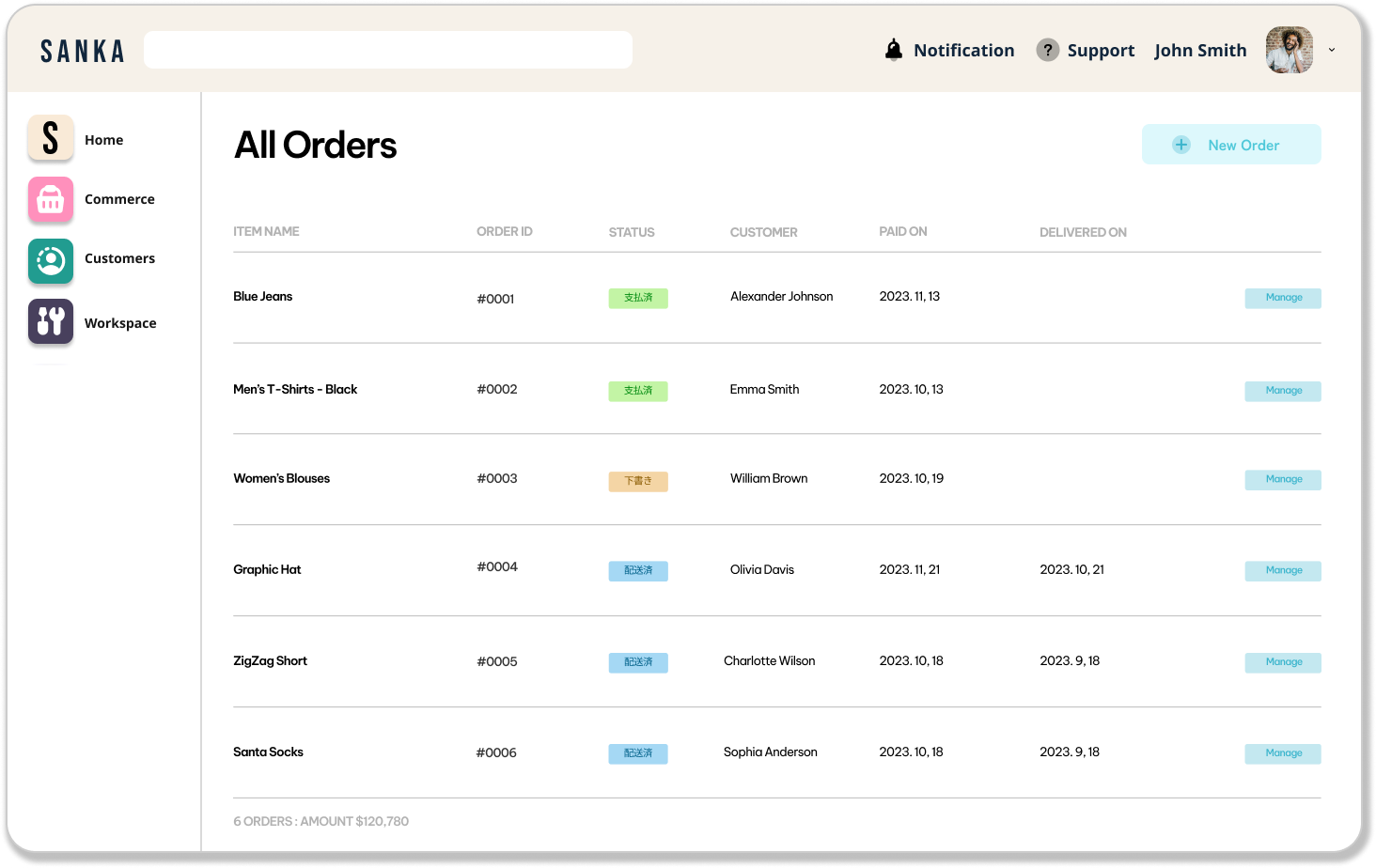What you will get from this article
- Define what is Enterprise Resource Planning (ERP)
- Understand how ERP can help transform your business
- Explore how Sanka, a leading automation tool, can make your ERP efforts more effective and efficient
Introduction
You know that running a successful business today requires efficiency, agility, and insight. As a leader responsible for driving growth and maximizing performance, you need tools and processes in place to gain visibility into operations, enable informed decision-making, and execute key business processes with speed and accuracy.
When it comes to running a successful business, enterprise resource planning (ERP) is crucial for increasing productivity, reducing costs, and driving growth.
Enterprise Resource Planning or ERP software provides an integrated system to manage your business's vital functions like accounting and finance, human resources, supply chain, and more.
By implementing an ERP solution, you can improve productivity, reduce costs, and gain real-time data and analytics to propel your organization forward.
In this article, we will explore how ERP software can help transform your business through increased efficiency, automation, and data-driven insights.
Additionally, explore how Sanka, a leading automation tool, can make your ERP efforts more effective and efficient.
What is Enterprise Resource Planning
In a nutshell, ERP is a centralized system that integrates various business processes, such as procurement, finance, human resources, and manufacturing to help you monitor and control your organization more efficiently.
This allows your teams to access accurate and up-to-date information and helps eliminate the issues associated with using different software tools for different departments.
Benefits of Enterprise Resource Planning (ERP)
Streamline Your Business Processes With ERP

To optimize your business performance, you should implement an Enterprise Resource Planning (ERP) system. An ERP integrates all your business processes into a single system with a shared database.
- Streamline workflow. An ERP automates and standardizes processes across finance, HR, manufacturing, and supply chain departments. This boosts efficiency by eliminating redundant tasks and ensuring consistent procedures.
- Improve data access. A shared database provides real-time data visibility across the organization. Employees can make better decisions with comprehensive, up-to-date information at their fingertips.
- Reduce costs. By automating processes and facilitating resource sharing, an ERP cuts operational costs. It also minimizes errors and redundancies, lowering waste.
- Enhance customer service. With integrated systems and information sharing, all departments have a single view of the customer. This makes it easier to address customer needs and provide a superior experience.
To gain these benefits, you must first evaluate your current systems and processes to determine how an ERP can best support your business goals and priorities.
Then, work with an ERP vendor to implement a solution customized to your needs. While transitioning to the new system may temporarily reduce productivity, comprehensive training and support will help your team leverage the ERP to its full potential.
One of the main benefits of ERP is streamlining your operations by automating and simplifying your transactions.
This centralization of information and integration of processes can lead to improved collaboration, less duplication of effort, and increased efficiency.
By using Sanka, your team can automate many of its daily tasks, speeding up the overall workflow. Give Sanka a try by visiting the Sanka website.
With the right ERP strategy and tools, your organization can achieve new levels of efficiency, productivity, and profitability. An integrated system connects all parts of your business, providing the information and tools for optimal performance.
Gain Visibility Into Your Entire Organization
To maximize business efficiency, implementing an enterprise resource planning (ERP) system provides visibility into your entire organization.
- Gain a holistic view of your key business processes. An ERP system integrates all your business functions—finance, HR, manufacturing, supply chain, and more—into a single system. This provides a comprehensive overview of your operations and financials across departments in one place.
- Improve data accuracy and integrity. An ERP eliminates the need for multiple data entry across systems. Information is entered once and shared across modules, reducing errors and ensuring high data quality and consistency.
- Enhance reporting and business intelligence. An ERP provides robust reporting and analytics tools to uncover key insights and support data-driven decision making. Track KPIs, identify trends, and generate reports on everything from inventory levels to sales forecasts to employee turnover rates.
- Automate and streamline business processes. An ERP can help automate routine tasks like billing, invoicing, and expense reimbursements. Workflow management tools enable you to design efficient approval chains and processes across your organization. This reduces paperwork, saves time, and allows employees to focus on high-value work.
By implementing an ERP solution, your business can operate with greater coordination and efficiency.
You'll gain the visibility and business insight needed to optimize your resources, boost productivity, and drive sustainable growth.
With an integrated ERP powering your business, you'll be poised to reach new heights of success.
Improve Decision Making With Analytics and Reporting

Enterprise resource planning (ERP) systems provide analytical tools and reporting capabilities that can significantly improve your business’s decision making.
Leverage Data Insights
- ERP systems centralize your business data, enabling you to easily access key metrics and key performance indicators (KPIs) across departments. You can analyze trends over time to identify opportunities for improvement and growth.
- Dashboards and reports provide visibility into how your business is performing. You can track progress against goals, spot issues early, and make data-driven decisions to optimize efficiency and increase productivity.
- Advanced analytics, business intelligence, and reporting tools give you actionable insights into your operations and finances. You can perform tasks like forecasting future demand, identifying sales trends, calculating profit margins, and more.
Streamline Processes
- ERP reporting tools eliminate manual data collection and spreadsheet-based reporting. Processes are automated and standardized across the system.
- Role-based access gives different user groups visibility into the reports and KPIs that are most relevant to their jobs. Executives can monitor key performance metrics, managers can track department goals, and employees have insight into their daily tasks.
- When data is integrated, consistent, and accessible in real-time, your teams can collaborate more effectively. This facilitates faster, more well-informed decision-making across departments.
Continuous Improvement
- The analytics and reporting in ERP platforms create opportunities for ongoing improvement and optimization. You can make incremental changes to business processes and measure the impacts over time.
- Regularly reviewing KPIs and reports helps identify what’s working and not working. You can then make adjustments to better meet customer needs, control costs, improve quality, and drive growth.
- With a data-driven approach to managing your business, you can achieve and sustain a competitive advantage through efficiency, innovation, and customer satisfaction. ERP reporting tools provide the insights to guide your journey toward high performance.
Reduce Costs and Enhance Profitability

Enterprise resource planning (ERP) software can help reduce costs and improve profitability in your business.
By streamlining processes and providing analytics on key performance indicators (KPIs), an ERP system enables you to enhance fiscal management.
Reduce Excess Expenditures
An ERP system promotes operational efficiency by eliminating redundant processes. It can automate and optimize procedures like billing, inventory management, and payroll to minimize wasted time and resources.
The system's dashboard also provides real-time visibility into spending across departments so you can identify and reduce excess expenditures.
Improve Forecasting Accuracy
With an ERP system, you gain access to historical data and reports that can inform more precise budgeting and forecasting.
The software tracks actual revenues and costs against projections so you can adjust forecasts to better predict future financial performance.
Accurate forecasting, in turn, allows you to make data-driven decisions on strategic investments to drive growth.
Increase Customer Lifetime Value
An ERP solution gives you a 360-degree view of your customers and their lifetime value to your company.
It collects and connects data across sales, marketing, and customer service so you can analyze key metrics like customer acquisition cost (CAC), retention, and churn rates.
These insights allow you to optimize customer experiences, improve satisfaction and boost customer lifetime value. By enhancing the customer experience, you can increase sales and gain a competitive advantage.
Streamline Audits
During audits, an ERP system reduces the time and resources required to collect and organize financial records.
The software maintains a centralized repository of data with strong security and access controls.
This makes it easier for auditors to review records and for your team to provide requested documentation.
Streamlining the audit process minimizes disruptions and allows you to continue focusing on running your business.
In summary, an ERP solution can significantly reduce costs, improve forecasting, increase customer lifetime value, and simplify audits.
By optimizing fiscal management, the system enhances your profitability and gives you a competitive edge.
Choose the Right ERP System for Your Needs
To maximize business efficiency, selecting an enterprise resource planning (ERP) system that aligns with your company’s needs and goals is essential. When evaluating options, consider the following factors:
Functionality
Analyze your business processes and determine which modules - such as finance, HR, supply chain, and CRM - are necessities.
Compare vendors’ offerings to find a system with robust functionality in your key areas. For complex operations or niche industries, customize the ERP or integrate third-party apps.
Scalability
As your company grows, the right ERP system will scale with you. Choose a solution that can expand to support more users, larger volumes of data, and increasingly complicated processes over time.
Cloud-based and on-premise options both offer scalable options. For the best of both worlds, some vendors provide hybrid ERP systems.
Ease of Use
An ERP system should streamline operations, not complicate them. Evaluate the user interface and experience to ensure all employees, regardless of technical aptitude, can navigate and utilize the system with relative ease.
Systems with intuitive design, minimal clutter, and logical workflow tend to rank higher in usability.
Deployment and Maintenance

Compare on-premise, cloud-based, and hybrid ERP solutions to determine the right deployment and maintenance option based on your IT requirements and resources.
On-premise ERPs demand significant resources but also provide full control and customization.
Cloud-based and hybrid ERP options offer more flexibility and scalability with less demand for internal resources.
Cost
The total cost of ownership including software licensing fees, implementation, customization, maintenance, and staff training varies significantly between ERP options.
Define your budget constraints upfront and look for systems that balance robust features with affordability.
Some vendors provide financing or subscription-based payment models to spread costs over time.
Selecting the ERP system that optimally supports your key business processes today and into the future is essential to improving operational efficiency, productivity and profitability.
Evaluating options based on your specific functionality needs, scalability, ease of use, deployment model and cost will help determine an effective and affordable solution for your organization.
Conclusion
In conclusion, investing in an enterprise resource planning system can offer significant benefits for your business.
ERP can give you the tools needed to drive success in today's competitive marketplace by streamlining your processes, improving decision-making, and reducing costs.
Sanka serves as an excellent choice for businesses looking for a modern, efficient, and adaptable ERP solution. To learn more and explore how Sanka can help your business succeed.








